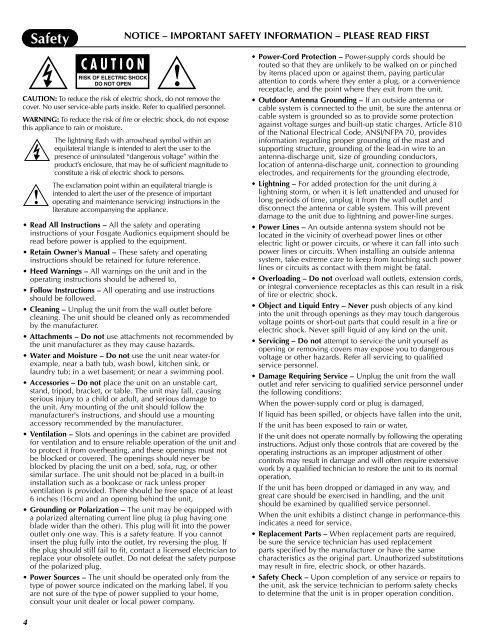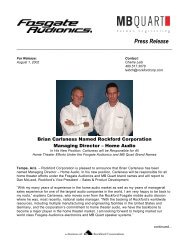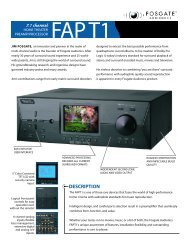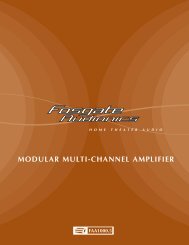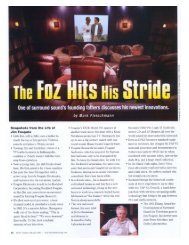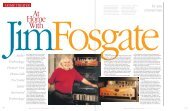7.1 channel preamp/processor - Fosgate Audionics
7.1 channel preamp/processor - Fosgate Audionics
7.1 channel preamp/processor - Fosgate Audionics
You also want an ePaper? Increase the reach of your titles
YUMPU automatically turns print PDFs into web optimized ePapers that Google loves.
4<br />
Safety<br />
NOTICE – IMPORTANT SAFETY INFORMATION – PLEASE READ FIRST<br />
CAUTION: To reduce the risk of electric shock, do not remove the<br />
cover. No user service-able parts inside. Refer to qualified personnel.<br />
WARNING: To reduce the risk of fire or electric shock, do not expose<br />
this appliance to rain or moisture.<br />
The lightning flash with arrowhead symbol within an<br />
equilateral triangle is intended to alert the user to the<br />
presence of uninsulated “dangerous voltage” within the<br />
product’s enclosure, that may be of sufficient magnitude to<br />
constitute a risk of electric shock to persons.<br />
The exclamation point within an equilateral triangle is<br />
intended to alert the user of the presence of important<br />
operating and maintenance (servicing) instructions in the<br />
literature accompanying the appliance.<br />
• Read All Instructions – All the safety and operating<br />
instructions of your <strong>Fosgate</strong> <strong>Audionics</strong> equipment should be<br />
read before power is applied to the equipment.<br />
• Retain Owner's Manual – These safety and operating<br />
instructions should be retained for future reference.<br />
• Heed Warnings – All warnings on the unit and in the<br />
operating instructions should be adhered to,<br />
• Follow Instructions – All operating and use instructions<br />
should be followed.<br />
• Cleaning – Unplug the unit from the wall outlet before<br />
cleaning. The unit should be cleaned only as recommended<br />
by the manufacturer.<br />
• Attachments – Do not use attachments not recommended by<br />
the unit manufacturer as they may cause hazards.<br />
• Water and Moisture – Do not use the unit near water-for<br />
example, near a bath tub, wash bowl, kitchen sink, or<br />
laundry tub; in a wet basement; or near a swimming pool.<br />
• Accessories – Do not place the unit on an unstable cart,<br />
stand, tripod, bracket, or table. The unit may fall, causing<br />
serious injury to a child or adult, and serious damage to<br />
the unit. Any mounting of the unit should follow the<br />
manufacturer's instructions, and should use a mounting<br />
accessory recommended by the manufacturer.<br />
• Ventilation – Slots and openings in the cabinet are provided<br />
for ventilation and to ensure reliable operation of the unit and<br />
to protect it from overheating, and these openings must not<br />
be blocked or covered. The openings should never be<br />
blocked by placing the unit on a bed, sofa, rug, or other<br />
similar surface. The unit should not be placed in a built-in<br />
installation such as a bookcase or rack unless proper<br />
ventilation is provided. There should be free space of at least<br />
6 inches (16cm) and an opening behind the unit,<br />
• Grounding or Polarization – The unit may be equipped with<br />
a polarized alternating current line plug (a plug having one<br />
blade wider than the other). This plug will fit into the power<br />
outlet only one way. This is a safety feature. If you cannot<br />
insert the plug fully into the outlet, try reversing the plug. If<br />
the plug should still fail to fit, contact a licensed electrician to<br />
replace your obsolete outlet. Do not defeat the safety purpose<br />
of the polarized plug.<br />
• Power Sources – The unit should be operated only from the<br />
type of power source indicated on the marking label. If you<br />
are not sure of the type of power supplied to your home,<br />
consult your unit dealer or local power company.<br />
• Power-Cord Protection – Power-supply cords should be<br />
routed so that they are unlikely to be walked on or pinched<br />
by items placed upon or against them, paying particular<br />
attention to cords where they enter a plug, or a convenience<br />
receptacle, and the point where they exit from the unit.<br />
• Outdoor Antenna Grounding – If an outside antenna or<br />
cable system is connected to the unit, be sure the antenna or<br />
cable system is grounded so as to provide some protection<br />
against voltage surges and built-up static charges. Article 810<br />
of the National Electrical Code, ANSI/NFPA 70, provides<br />
information regarding proper grounding of the mast and<br />
supporting structure, grounding of the lead-in wire to an<br />
antenna-discharge unit, size of grounding conductors,<br />
location of antenna-discharge unit, connection to grounding<br />
electrodes, and requirements for the grounding electrode,<br />
• Lightning – For added protection for the unit during a<br />
lightning storm, or when it is left unattended and unused for<br />
long periods of time, unplug it from the wall outlet and<br />
disconnect the antenna or cable system. This will prevent<br />
damage to the unit due to lightning and power-line surges.<br />
• Power Lines – An outside antenna system should not be<br />
located in the vicinity of overhead power lines or other<br />
electric light or power circuits, or where it can fall into such<br />
power lines or circuits. When installing an outside antenna<br />
system, take extreme care to keep from touching such power<br />
lines or circuits as contact with them might be fatal.<br />
• Overloading – Do not overload wall outlets, extension cords,<br />
or integral convenience receptacles as this can result in a risk<br />
of fire or electric shock.<br />
• Object and Liquid Entry – Never push objects of any kind<br />
into the unit through openings as they may touch dangerous<br />
voltage points or short-out parts that could result in a fire or<br />
electric shock. Never spill liquid of any kind on the unit.<br />
• Servicing – Do not attempt to service the unit yourself as<br />
opening or removing covers may expose you to dangerous<br />
voltage or other hazards. Refer all servicing to qualified<br />
service personnel.<br />
• Damage Requiring Service – Unplug the unit from the wall<br />
outlet and refer servicing to qualified service personnel under<br />
the following conditions:<br />
When the power-supply cord or plug is damaged,<br />
If liquid has been spilled, or objects have fallen into the unit,<br />
If the unit has been exposed to rain or water,<br />
If the unit does not operate normally by following the operating<br />
instructions. Adjust only those controls that are covered by the<br />
operating instructions as an improper adjustment of other<br />
controls may result in damage and will often require extensive<br />
work by a qualified technician to restore the unit to its normal<br />
operation,<br />
If the unit has been dropped or damaged in any way, and<br />
great care should be exercised in handling, and the unit<br />
should be examined by qualified service personnel.<br />
When the unit exhibits a distinct change in performance-this<br />
indicates a need for service.<br />
• Replacement Parts – When replacement parts are required,<br />
be sure the service technician has used replacement<br />
parts specified by the manufacturer or have the same<br />
characteristics as the original part. Unauthorized substitutions<br />
may result in fire, electric shock, or other hazards.<br />
• Safety Check – Upon completion of any service or repairs to<br />
the unit, ask the service technician to perform safety checks<br />
to determine that the unit is in proper operation condition.


